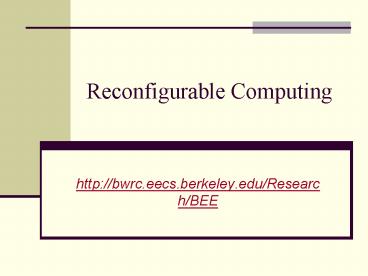Reconfigurable Computing - PowerPoint PPT Presentation
1 / 11
Title:
Reconfigurable Computing
Description:
Emulations of ASICs with 10 Million gate-equivalents. Corresponds to 600 Gops (16-bit adds) ... Emulation of new reconfigurable architectures and programmable ASICs: ... – PowerPoint PPT presentation
Number of Views:58
Avg rating:3.0/5.0
Title: Reconfigurable Computing
1
Reconfigurable Computing
- http//bwrc.eecs.berkeley.edu/Research/BEE
2
Reconfigurable Computing for Flexible Radios
- The project grows out of two prior projects
- BEE (Berkeley Emulation Engine)
- BRASS (Berkeley Reconfigurable Architectures,
Software, and Systems) - Reconfigurable processors demonstrate 10-100x
performance improvement over processors. - Our new project places heavy demands on a new
computing cluster.
3
Berkeley Emulation Engine
- FPGA-based system for real-time hardware
emulation - Emulations of ASICs with 10 Million
gate-equivalents. Corresponds to 600 Gops (16-bit
adds) - 2400 external parallel I/Os providing 192 Gbps
raw bandwidth, for in-system chip emulation.
- Tool-flow maps designs to both FPGA emulation and
ASIC layout.
- Emulation of
- QPSK radio transceiver, BCJR decoder, UWB
mix-signal SOC, Pico-radio multi-node system,
Infineon SIMD processor for SDR
4
BEE2 (the new BEE)
- Scaled-up BEE architecture
- Based on state-of-art Xilinx Virtex 2 Pro 100
FPGA. - Five FPGAs plus DRAM per processing module.
- Multiple modules (up to 64) wired together with
high-speed interconnect. - Extends BEE performance to 75 TeraOp/s and 3
TFLOP/s range. - Leverages BEE design experience and tool-flow.
- Collaboration with Xilinx
- Ivo Bolsens, Bob Conn
5
BEE2 (the new BEE)
- SDR, Cognitive radio, and Ad-hoc wireless
networks - Platform for developing soft-radio techniques,
validation of network protocols. - Chip-level validation in context of real data and
network/environment conditions. - High-end computing tasks
- Full-chip SPICE simulation, E M simulation for
antenna design - Emulation of new reconfigurable architectures and
programmable ASICs - Model for future single-chip reconfigurable
computing architectures - (BEE2 will be eventually be a single device).
6
Unique Characteristics
- Massive parallelism at many levels
- 100 to 1000s of FPGAs, Massive parallelism
within each FPGA (100K logic blocks). - Many opportunities for optimal area-time
tradeoffs. - Computation normally spreads out in space rather
than in time. - Conventional high-end machines have massive
parallelism only at the course level. - Low-level circuits customized on a per problem
basis - Custom word-width, operator type, hard-wired
control, custom communication circuits, circuit
specialization around known constants, etc.
7
Unique Characteristics
- Each computing node (FPGA) is customized
individually. - Spatial model of computation spreads computation
modes of problem over nodes of machine, rather
than in time (phases). - As opposed to standard SPMD model of
conventional high-end computers. - Low-level redundancy of FPGAs allows for
manufacturing defect tolerance. - Huge savings in cost - impossible with
processors.
These characteristics create computational
challenges for the mapping software.
8
Tool Flow
HDL circuit spec.
FPGA conf. files
logic synthesis
logic mapping
circuit placement
circuit routing
Xilinx low-level PPR tools
- PPR is time consuming step. Typical run times
for mapping a design to a large FPGA device is
several hours. - Remember, we are planning on 100s of FPGAs.
- Mapping tools are rudimentary (no optimal design
guaranteed from high-level description), so
designs are hand-crafted and many iterations of
tool flow is common. - Using devices with defects many require multiple
mapping runs to avoid faults. - Fortunately, PPR is embarrassingly parallel.
All chips can be placed and routed in parallel on
a cluster of workstations.
9
Tool Flow
- Eventually, tool flow will be sped up by
- Better high-level specification to optimal
design, eliminating the need for iteration
through the flow, and taking advantage of problem
specific regularity and structure. - Modular design, reliance on optimized libraries,
- Parallelization of tools Reconfigurable
computers can someday run their own tools.
10
Status
- BEE2 will be fabbricated this summer and will
become the base of our future work on
reconfigurable computing - I/O analog transceivers are being developed to
allow the implementation of cognitive radios that
work with real channels and interference
11
The BEE2 Team
- Faculty
- John Wawrzynek
- Bob W. Brodersen
- Graduate students
- Chen Chang
- Pierre-Yves Droz
- Nan Zhou
- Yury Markovskiy
- Hayden So
- Kevin Camera
- Zohair Hyder
- Xilinx
- Bob Conn
- Ivo Bolsens
- Research associates
- Andrei Vladimirescu
- Vason Srini
- Technical staff
- Brian Richards
- Susan H. Mellers
- Undergraduate student
- Alexander Krasnov
- Greg Gibeling
- Jeffry West
- John Conner































